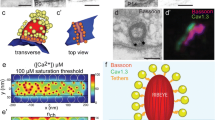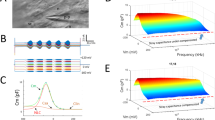Abstract
The size and locations of pre-synaptic ribbons and glutamate receptors within and around inner hair cells are correlated with auditory afferent response features such as the spontaneous discharge rate (SR), threshold, and dynamic range of sound intensity representation (the so-called SR-groups). To test if the development of these spatial gradients requires experience with sound intensity, we quantified the size and spatial distribution of synaptic ribbons from the inner hair cells of neonatal rats before and after the onset of hearing (from post-natal day (P) 3 to P33). To quantify ribbon size, we used high resolution fluorescence confocal microscopy and 3-D reconstructions of immunolabeled ribbons. The size, density, and spatial distribution of ribbons changed during development. At P3, ribbons were densely clustered near the basal/modiolar face of the hair cell where low SR-groups preferentially contact adult hair cells. By P12, the disparity in ribbon count was less striking and ribbons were equally likely to occupy both faces. At all ages before P12, ribbons were larger on the modiolar face than on the pillar face. These differences initially grew larger with age but collapsed around the onset of hearing. Between P12 and P33, the spatial gradients remained small and began to re-emerge around P33. Even by P12, we did not find spatial gradients in the size of the post-synaptic glutamate receptors as is found on afferent terminals contacting adult inner hair cells. These results suggest that spatial gradients in ribbon size develop in the absence of sensory experience.





Similar content being viewed by others
References
Barbary AE (1991) Auditory nerve of the normal and jaundiced rat. I. Spontaneous discharge rate and cochlear nerve histology. Hear Res 54:75–90
Bergeron AL, Schrader A, Yang D, Osman AA, Simmons DD (2005) The final stage of cholinergic differentiation occurs below inner hair cells during development of the rodent cochlea. JARO - J Assoc Res Otolaryngol 6:401–415
Beutner D, Moser T (2001) The presynaptic function of mouse cochlear inner hair cells during development of hearing. J Neurosci 21:4593–4599
Defourny J, Lallemend F, Malgrange B (2011) Structure and development of cochlear afferent innervation in mammals. Am J Physiol Cell Physiol 301:C750–C761
Echteler SM (1992) Developmental segregation in the afferent projections to mammalian auditory hair cells. Proc Natl Acad Sci U S A 89:6324–6327
Furman AC, Kujawa SG, Liberman MC (2013) Noise-induced cochlear neuropathy is selective for fibers with low spontaneous rates. J Neurophysiol 110:577–586
Geal-Dor M, Freeman S, Li G, Sohmer H (1993) Development of hearing in neonatal rats: air and bone conducted ABR thresholds. Hear Res 69:236–242
Glowatzki E, Fuchs P (2002) Transmitter release at the hair cell ribbon synapse. Nat Neurosci 5:147–154
Graham CE, Vetter DE (2011) The mouse cochlea expresses a local hypothalamic-pituitary-adrenal equivalent signaling system and requires corticotropin-releasing factor receptor 1 to establish normal hair cell innervation and cochlear sensitivity. J Neurosci 31:1267–1278
Grant L, Yi E, Glowatzki E (2010) Two modes of release shape the postsynaptic response at the inner hair cell ribbon synapse. J Neurosci 30:4210–4220
Hallworth R, Ludueña RF (2000) Differential expression of β tubulin isotypes in the adult gerbil cochlea. Hear Res 148:161–172
Hermes B, Reuss S, Vollrath L (1992) Synaptic ribbons, spheres and intermediate structures in the developing rat retina. Int J Dev Neurosci 10:215–223
Hickman TT, Liberman MC, Jacob MH (2015) Adenomatous polyposis coli protein deletion in efferent olivocochlear neurons perturbs afferent synaptic maturation and reduces the dynamic range of hearing. J Neurosci 35:9236–9245
Huang L-C, Thorne PR, Housley GD, Montgomery JM (2007) Spatiotemporal definition of neurite outgrowth, refinement and retraction in the developing mouse cochlea. Development 134:2925–2933
Huang L-C, Barclay M, Lee K, Peter S, Housley GD, Thorne PR, Montgomery JM (2012) Synaptic profiles during neurite extension, refinement and retraction in the developing cochlea. Neural Dev 7:38
Jewett DL, Romano MN (1972) Neonatal development of auditory system potentials averaged from the scalp of rat and cat. Brain Res 36:101–115
Johnson SL, Franz C, Knipper M, Marcotti W (2009) Functional maturation of the exocytotic machinery at gerbil hair cell ribbon synapses. J Physiol 587:1715–1726
Johnson SL, Eckrich T, Kuhn S, Zampini V, Franz C, Ranatunga KM, Roberts TP, Masetto S, Knipper M, Kros CJ, Marcotti W (2011) Position-dependent patterning of spontaneous action potentials in immature cochlear inner hair cells. Nat Neurosci 14:711–717
Johnson SL, Kuhn S, Franz C, Ingham N, Furness DN, Knipper M, Steel KP, Adelman JP, Holley MC, Marcotti W. (2013a). Presynaptic maturation in auditory hair cells requires a critical period of sensory-independent spiking activity. doi: 10.1073/pnas.1219578110/-/DCSupplemental.www.pnas.org/cgi/doi/10.1073/pnas.1219578110
Johnson SL, Wedemeyer C, Vetter DE, Adachi R, Holley MC, Bele A. (2013b). Cholinergic efferent synaptic transmission regulates the maturation of auditory hair cell ribbon synapses
Kantardzhieva A, Liberman MC, Sewell WF (2013) Quantitative analysis of ribbons, vesicles, and cisterns at the cat inner hair cell synapse: correlations with spontaneous rate. J Comp Neurol 521:3260–3271
Khimich D, Nouvian R, Pujol RR, Tom Dieck S, Egner A, Gundelfinger ED, Moser T, Noublan R (2005) Hair cell synaptic ribbons are essential for synchronous auditory signalling. Nature 434:889–894
Kim KX, Rutherford MA (2016) Maturation of NaV and KV channel topographies in the auditory nerve spike initiator before and after developmental onset of hearing function. J Neurosci 36:2111–2118
Kros CJ (1998) Expression of a potassium current in inner hair cells during development of hearing in mice. Nature 394:281–284
Liberman MC (1982) Single-neuron labeling in the cat auditory nerve. Science 216(80):1239–1241
Liberman LD, Wang H, Liberman MC (2011) Opposing gradients of ribbon size and AMPA receptor expression underlie sensitivity differences among cochlear-nerve/hair-cell synapses. J Neurosci 31:801–808
Liberman LD, Liberman MC (2016) Postnatal maturation of auditory-nerve heterogeneity, as seen in spatial gradients of synapse morphology in the inner hair cell area. Hear Res 339: 12–22
Liu Q, Davis RL (2007) Regional specification of threshold sensitivity and response time in CBA/CaJ mouse spiral ganglion neurons. J Neurophysiol 98:2215–2222
Liu W, Davis RL (2014) Calretinin and calbindin distribution patterns specify subpopulations of type I and type II spiral ganglion neurons in postnatal murine cochlea. J Comp Neurol 522:2299–2318
Maxeiner S, Luo F, Tan A, Schmitz F, Südhof TC. (2016). How to make a synaptic ribbon: RIBEYE deletion abolishes ribbons in retinal synapses and disrupts neurotransmitter release. doi: 10.15252/embj.201592701
Mehta B, Snellman J, Chen S, Li W, Zenisek D (2013) Synaptic ribbons influence the size and frequency of miniature-like evoked postsynaptic currents. Neuron 77:516–527
Merchan-Perez A, Liberman MC (1996) Ultrastructural differences among afferent synapses on cochlear hair cells: correlations with spontaneous discharge rate. J Comp Neurol 371:208–221
Nagiel A, Patel SH, Andor-Ardó D, Hudspeth AJ (2009) Activity-independent specification of synaptic targets in the posterior lateral line of the larval zebrafish. Proc Natl Acad Sci U S A 106:21948–21953
Ohn T-L, Rutherford MA, Jing Z, Jung S, Duque-Afonso CJ, Hoch G, Picher MM, Scharinger A, Strenzke N, Moser T (2016) Hair cells use active zones with different voltage dependence of Ca 2+ influx to decompose sounds into complementary neural codes. Proc Natl Acad Sci. doi:10.1073/pnas.1605737113
Roth B, Bruns V (1992) Postnatal development of the rat organ of Corti. Anat Embryol (Berl) 185:571–581
Rutherford MA (2015) Resolving the structure of inner ear ribbon synapses with STED microscopy. Synapse 69:242–255
Rutherford MA, Chapochnikov NM, Moser T (2012) Spike encoding of neurotransmitter release timing by spiral ganglion neurons of the cochlea. J Neurosci 32:4773–4789
Schmitz F, Königstorfer A, Südhof T (2000) RIBEYE, a component of synaptic ribbons: a protein’s journey through evolution provides insight into synaptic ribbon function. Neuron 28:857–872
Sendin G, Bulankina AV, Riedel D, Moser T (2007) Maturation of ribbon synapses in hair cells is driven by thyroid hormone. J Neurosci 27:3163–3173
Sheets L, Trapani JG, Mo W, Obholzer N, Nicolson T (2011) RIBEYE is required for presynaptic Ca(V)1.3a channel localization and afferent innervation of sensory hair cells. Development 138:1309–1319
Sheets L, Kindt KS, Nicolson T (2012) Presynaptic CaV1.3 channels regulate synaptic ribbon size and are required for synaptic maintenance in sensory hair cells. J Neurosci 32:17273–17286
Siegel JH (1992) Spontaneous synaptic potentials from afferent terminals in the guinea pig cochlea. Most 59:85–92
Simmons DD (2002) Development of the inner ear efferent system across vertebrate species. J Neurobiol 53:228–250
Simmons DD, Manson-Gieseke L, Hendrix TW, McCarter S (1990) Reconstructions of efferent fibers in the postnatal hamster cochlea. Hear Res 49:127–139
Simmons DD, Mansdorf NB, Kim JH (1996) Olivocochlear innervation of inner and outer hair cells during postnatal maturation: evidence for a waiting period. J Comp Neurol 370:551–562
Sobkowicz HM, Rose JE, Scott GE, Slapnick SM (1982) Ribbon synapses in the developing intact and cultured organ of Corti in the mouse. J Neurosci 2:942–957
Taberner A (2005) Response properties of single auditory nerve fibers in the mouse. J Neurophysiol. doi:10.1152/jn.00574.2004
Tritsch NX, Bergles DE (2010) Developmental regulation of spontaneous activity in the mammalian cochlea. J Neurosci 30:1539–1550
Waguespack J, Salles FT, Kachar B, Ricci AJ (2007) Stepwise morphological and functional maturation of mechanotransduction in rat outer hair cells. J Neurosci 27:13890–13902
Walsh EJ, McGee J (1987) Postnatal development of auditory nerve and cochlear nucleus neuronal responses in kittens. Hear Res 28:97–116
Wong AB, Rutherford MA, Gabrielaitis M, Pangrsic T, Göttfert F, Frank T, Michanski S, Hell S, Wolf F, Wichmann C, Moser T (2014) Developmental refinement of hair cell synapses tightens the coupling of Ca2+ influx to exocytosis. EMBO J 33:247–264
Yi E, Roux I, Glowatzki E (2010) Dendritic HCN channels shape excitatory postsynaptic potentials at the inner hair cell afferent synapse in the mammalian cochlea. J Neurophysiol 103:2532–2543
Yin Y, Liberman LD, Maison SF, Liberman MC (2014) Olivocochlear innervation maintains the normal modiolar-pillar and habenular-cuticular gradients in cochlear synaptic morphology. JARO - J Assoc Res Otolaryngol 15:571–583
Acknowledgements
This work was funded by the NIH-National Institute of Deafness and Communication Disorders grants RO3 DC012652 (to RK), P30 DC10743 (to the House Research Institute) and by the University of Southern California. We acknowledge Saya Yusa for her contribution to the preliminary studies that preceded this work. We thank Li Zhang for providing access to the confocal microscope, Seth Ruffins and USC Stem Cell Imaging Center for providing training and access to the Imaris Software and Laurel Fisher for advice on statistics. We thank Alexander Markowitz, Christopher Ventura, Neil Segil, and three anonymous reviewers for their valuable comments on this manuscript.
Author information
Authors and Affiliations
Corresponding author
Ethics declarations
Conflict of Interest
The authors declare that they have no conflict of interest.
Rights and permissions
About this article
Cite this article
Kalluri, R., Monges-Hernandez, M. Spatial Gradients in the Size of Inner Hair Cell Ribbons Emerge Before the Onset of Hearing in Rats. JARO 18, 399–413 (2017). https://doi.org/10.1007/s10162-017-0620-1
Received:
Accepted:
Published:
Issue Date:
DOI: https://doi.org/10.1007/s10162-017-0620-1




